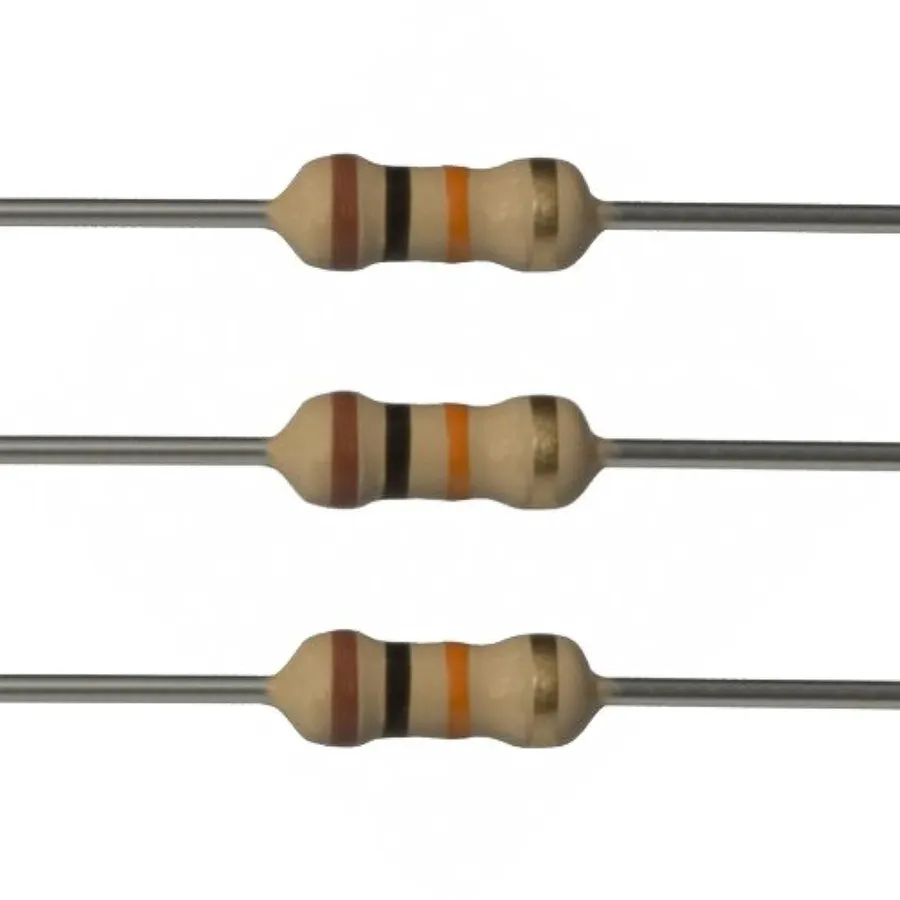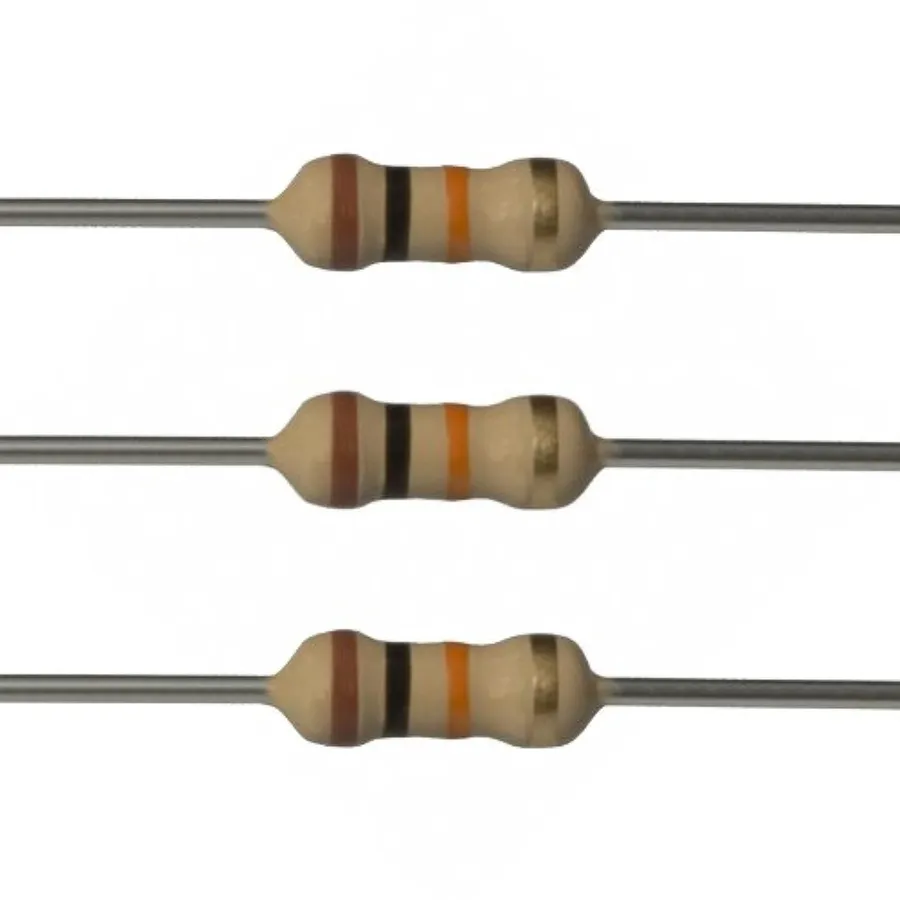Unlocking the Power of the 10k Ohm Resistor: A Comprehensive Guide

In the world of electronics, the seemingly humble 10 kilo ohm resistor plays a vital role, akin to a traffic controller managing the flow of electrons. From simple LED circuits to complex microcontrollers like Arduino, the 10k ohm resistor is indispensable. This article unravels the significance of the 10k ohm resistor, its workings, and its diverse applications, illuminating its importance in both hobbyist projects and industrial machinery.
Understanding the Basics of a 10k Ohm Resistor

The 10k ohm resistor is a fundamental component in electronics, characterized by its specific resistance of 10,000 ohms. This value dictates the extent to which the resistor impedes the flow of electrical current, a crucial property for circuit design and function. Understanding resistance, measured in ohms (Ω), and the meaning of the '10k' designation is essential for properly utilizing this common component.
In electrical terms, resistance is the opposition to the flow of electric current. It is analogous to friction in a mechanical system. The ohm (Ω), named after Georg Simon Ohm, is the standard unit of electrical resistance. A 10k ohm resistor, therefore, provides 10,000 ohms of resistance to the current passing through it. The 'k' denotes kilo, which is a prefix meaning 1000, thus 10k = 10 * 1000 = 10,000 ohms.
The significance of a 10k ohm resistance value lies in its widespread use in numerous applications, offering a balance between current limiting and signal management. Its moderate resistance makes it suitable for a range of functions, including limiting current in LED circuits, serving as pull-up or pull-down resistors in digital logic, and creating voltage dividers. The 10k ohm resistor is a go-to component for both hobbyists and professional engineers due to its versatile properties.
Deciphering the 10k Ohm Resistor Color Code

The color code on a 10k ohm resistor is a standardized system used to quickly identify its resistance value and tolerance. Typically, a 10k ohm resistor will have four or five color bands. The four-band configuration is most common, following a sequence that directly translates to the resistor's value, and the five-band configuration increases precision. Understanding this code is crucial for accurately selecting components in electronics projects. The most common code for a 10k ohm resistor is Brown-Black-Orange-Gold for a four band resistor, or Brown-Black-Black-Red-Gold for a five band resistor.
| Band | Color | Digit Value | Multiplier Value | Tolerance Value |
|---|---|---|---|---|
| 1st Band | Brown | 1 | ||
| 2nd Band | Black | 0 | ||
| 3rd Band | Orange | 1,000 (10^3) | ||
| 4th Band | Gold | ±5% | ||
| 3rd Band | Black | 1 | ||
| 4th Band | Red | 100 (10^2) | ||
| 5th Band | Gold | ±5% |
For a four-band resistor, the first two bands represent the first and second digits of the resistance value, the third band is a multiplier, and the fourth band represents tolerance. In our 10k ohm case (Brown-Black-Orange-Gold), Brown is 1, Black is 0, which gives us 10. The Orange band indicates a multiplier of 1,000, resulting in a value of 10,000 ohms. The gold band indicates a ±5% tolerance. For a five-band resistor, the first three bands represent the digits, the fourth band is the multiplier, and the fifth band indicates tolerance.
Tolerance indicates the precision of the resistor's actual value, with Gold representing ±5% tolerance, this means the actual value of the 10k ohm resistor may be between 9.5k ohms and 10.5k ohms. Understanding the color code helps ensure that the appropriate resistor is selected for a project and that the desired circuit function is accurately achieved.
Key Applications of 10k Ohm Resistors in Electronics

The 10k ohm resistor is a versatile component in electronics, utilized across a wide range of applications due to its moderate resistance value. Its role is pivotal in controlling current flow, establishing stable voltage levels, and facilitating signal processing in various circuits. This section delves into three key applications: current limiting for LEDs, pull-up/pull-down resistor configurations, and voltage division.
Current Limiting for LEDs: A primary use for a 10k ohm resistor is to limit the current passing through a Light Emitting Diode (LED). LEDs require a specific forward current to operate correctly, and excessive current can damage them. By placing a 10k ohm resistor in series with the LED, the current is controlled to a safe level. Ohm's Law dictates the relationship, V = IR, so adding a resistor increases the total resistance and reduces the circuit current.
Pull-up and Pull-down Resistors: In digital circuits, 10k ohm resistors frequently function as pull-up or pull-down resistors. These are used to establish a defined logic state (high or low) at an input pin when no signal is applied. A pull-up resistor connects the input to a high voltage supply, while a pull-down connects it to the ground. The 10k resistance provides enough resistance to prevent excessive current flow while still reliably establishing a defined state. The actual pull-up/pull-down resistor value can vary based on the circuit, but 10k is a common and effective choice.
Voltage Dividers: A voltage divider circuit uses two or more resistors to reduce a higher voltage to a lower one. A 10k ohm resistor, when combined with other resistor values, is used to create a specific voltage output. The output voltage is proportional to the resistance ratio based on the following equation: Vout = Vin * (R2 / (R1 + R2))
These applications illustrate the versatility of the 10k ohm resistor. Its moderate resistance allows it to be effective in both current limiting and voltage manipulation, making it a staple in many electronic circuits.
10k Ohm Resistors in Arduino Projects

The 10k ohm resistor is a ubiquitous component in Arduino projects, playing a crucial role in ensuring stable and reliable digital and analog signal processing. Its primary use revolves around pull-up and pull-down configurations, and sensor interfacing. These configurations are essential for handling various input devices like buttons, switches, and analog sensors.
- Pull-up Resistors
A pull-up resistor connects a digital input pin to the positive voltage rail (typically 5V or 3.3V). In the absence of an external signal, the input is held HIGH. When a button or switch is pressed, the input is pulled LOW by connecting to ground, providing a definitive change in state. This avoids floating inputs which can cause erratic behavior. Many Arduino boards have internal pull-up resistors, but external 10k ohm resistors are commonly used for greater stability. - Pull-down Resistors
Conversely, a pull-down resistor connects a digital input pin to ground. The pin is held LOW by default, and when an external input is applied (e.g., button press), the voltage will be pulled HIGH by the external source. Again, this prevents floating input issues and provides a stable default state, where using external resistors are particularly useful with sensors that have weak or uncertain signals. - Analog Sensors
10k ohm resistors are also used as part of voltage divider circuits with analog sensors. When combined with a sensor that varies its resistance, such as a potentiometer or thermistor, a voltage divider circuit is created, allowing an Arduino's analog input pin to measure the sensor's resistance changes by changes in voltage. This measurement is then utilized by the Arduino to analyze sensor data.
Frequently Asked Questions About 10k Ohm Resistors
This section addresses common inquiries about 10k ohm resistors, providing practical guidance on their characteristics, usage, and selection. Understanding these aspects is crucial for effective circuit design and troubleshooting.
- What are the standard physical sizes of a 10k ohm resistor?
10k ohm resistors come in various physical sizes, primarily dictated by their power rating and mounting style. Through-hole resistors, often used in prototyping, are commonly available in 1/4W and 1/2W sizes, while surface mount (SMD) resistors have standardized sizes like 0805, 0603, and 0402, each with varying dimensions for automated assembly processes. The physical size has a direct relationship to the resistor's ability to dissipate heat. - Is it safe to use a higher or lower ohm resistor as a direct replacement for a 10k ohm resistor?
Substituting a 10k ohm resistor with a significantly different value is generally not advisable and can severely impact circuit functionality. Using a higher value will reduce current flow, while a lower value increases it. For example, if the 10k ohm resistor is used as a pull-up, a significantly lower value can cause excessive current draw, while a much higher value may not correctly pull up the signal. Slight variations (e.g., a 9.1k or 11k ohm) may be acceptable in some non-critical applications, however, direct substitution without understanding the circuit's purpose is risky. Always consider the circuit’s specific operating parameters and tolerances. - What is the significance of power rating when selecting a 10k ohm resistor?
The power rating of a 10k ohm resistor, typically measured in watts (W), indicates the maximum power the resistor can safely dissipate as heat without damage. Choosing a resistor with an inadequate power rating can lead to overheating, resistor failure, and potentially damage to other components. Always select a resistor with a power rating equal to or greater than the anticipated power dissipation in the circuit. Power dissipation (P) can be estimated using P = I²R (where I is the current and R is the resistance) or P=V²/R (where V is voltage across the resistor). A safety margin of 20% or more is recommended to ensure operational reliability. - What are the differences between 1/4W and 1/6W rated 10k ohm resistors?
The primary difference between 1/4W and 1/6W rated 10k ohm resistors is their power dissipation capability. A 1/4W resistor can handle up to 0.25 watts of power, whereas a 1/6W resistor can handle up to approximately 0.167 watts. Physically, 1/4W resistors are usually larger, allowing for better heat dissipation. Choosing between them depends on the expected power dissipation in the circuit. If the calculated power dissipation is near or exceeds the 1/6W rating, selecting a 1/4W resistor is necessary to ensure the resistor does not overheat or fail. - Can I use a 10k ohm resistor for an LED?
Yes, a 10k ohm resistor can be used with an LED, but its suitability depends on the specific LED and the voltage of the power supply. Typically, a 10k ohm resistor is too high a value for a typical LED current limiting application. An appropriate current limiting resistor for an LED in a low-voltage circuit would more likely be in the range of 100-1000 ohms, depending on forward voltage drop and desired current. However, 10k ohm resistors can be used in LED indicator circuits where the objective is only to dimly light the LED with a low current, or as part of an LED dimming circuit, but not as a typical current limiting resistor for an LED. The resistor value needs to be calculated based on the specific circuit parameters, especially for high-brightness LEDs. - How does the tolerance of a 10k ohm resistor affect its performance?
The tolerance of a 10k ohm resistor indicates the allowed deviation from its nominal resistance value. For instance, a 10k ohm resistor with a 5% tolerance can have a resistance between 9.5k ohms and 10.5k ohms. In most general-purpose applications, 5% or 1% tolerance resistors are adequate. Precision circuits, such as those found in instrumentation or audio applications, might require resistors with tighter tolerances (0.1% or lower). The impact of tolerance depends on the circuit's design sensitivity to resistance variations. Understanding and selecting the correct tolerance is crucial for ensuring the circuit performs as intended.
Choosing the Right 10k Ohm Resistor for Your Project

Selecting the appropriate 10k ohm resistor is crucial for optimal circuit performance and reliability. This choice involves considering several key factors beyond the resistance value itself, including tolerance, power rating, and mounting style. A mismatch can lead to circuit malfunction or premature component failure. Understanding these factors will ensure your resistor operates within its specifications.
| Parameter | Description | Considerations |
|---|---|---|
| Tolerance | The allowable variation in the resistor's actual resistance from its nominal value (10k ohms). | Expressed as a percentage (e.g., ±1%, ±5%, ±10%). Choose tighter tolerances for precision circuits; looser tolerances are acceptable for less critical applications. |
| Power Rating | The maximum power (in Watts) that the resistor can dissipate without overheating or damage. | Common values include 1/8W, 1/4W, 1/2W. Select a power rating that exceeds the expected power dissipation in the circuit, ensuring a safety margin to prevent overheating and failure. |
| Mounting Style | The method of physically attaching the resistor to a circuit board. | Common options include through-hole (leaded) for breadboard or prototyping and surface mount (SMD) for compact and permanent installations. Choose based on your project assembly needs. |
| Temperature Coefficient | How much the resistance value changes with temperature. | Important for designs where temperature variation is expected, you will need to consider the temperature coefficient. |
| Package Size | Physical dimensions of the resistor. | SMD resistors come in various standard sizes (e.g., 0603, 0805, 1206) which should match your design. |
| Operating Voltage | Maximum voltage that can be safely applied to the resistor. | Ensure the maximum voltage of your circuit will not exceed the maximum voltage rating of the resistor. |
Comparing 10k Ohm Resistors with Other Common Resistor Values
While a 10k ohm resistor is a versatile component in electronics, understanding its differences from other common resistor values like 220 ohm and 1k ohm is crucial for effective circuit design. The choice of resistor value significantly impacts circuit behavior, and selecting the appropriate value ensures optimal performance.
| Resistor Value | Typical Application | Current Limiting Capability | Voltage Division Characteristics |
|---|---|---|---|
| 220 Ohm | LED current limiting, low impedance loads | High, allows more current flow | Less effective in voltage division due to low resistance |
| 1k Ohm | Current limiting, moderate impedance loads, sensor interfaces | Medium, offers a balance between current and voltage changes | Effective for moderate voltage division |
| 10k Ohm | Pull-up/pull-down resistors, voltage dividers, analog sensors | Low, limits current significantly | Excellent for voltage division, stable signal for digital inputs |
A 220 ohm resistor is commonly used for limiting current to LEDs where a relatively high current is needed but must be limited to prevent damage. Its low resistance allows more current to flow, making it less suitable for applications that require a substantial voltage drop. In contrast, a 1k ohm resistor offers a moderate level of current limiting and is often used in sensor interfaces or as part of a simple voltage divider. The 10k ohm resistor, with its higher resistance, is ideal for pull-up or pull-down applications in digital circuits, providing stable signal levels for logic inputs, and creating accurate voltage division with minimal current draw. The key advantage of a 10k ohm resistor in such scenarios is its higher resistance which ensures minimal current flow, thereby conserving energy and reducing heat generation in the circuit.
The selection between 220 ohm, 1k ohm, and 10k ohm resistors hinges on the specific requirements of the circuit. For high current applications, lower values like 220 ohms are favored. For moderate current and voltage dividing situations 1k ohm is a reasonable choice and for digital circuits that need stable logic levels or analog signal interfaces, 10k ohm resistors are preferred for their low current consumption and excellent voltage division characteristics.
Troubleshooting Common Issues with 10k Ohm Resistors
Effective troubleshooting of 10k ohm resistor issues requires a systematic approach, considering common failure modes such as incorrect connections, thermal stress from overheating, and damage due to over-voltage conditions. Recognizing these potential problems allows for prompt corrective action.
- Incorrect Connections
A common problem is miswiring the resistor in the circuit, ensure the resistor is placed in the correct position according to the schematic. Double-check your wiring diagram against the actual physical circuit. - Overheating
Resistors can overheat if subjected to power levels that exceed their rated capacity, or are placed too close to heat-generating components without proper thermal management. Overheated resistors can change in value, leading to circuit malfunction. Always verify the resistor's power dissipation using Ohm’s Law and ensure it is rated to handle the expected power. - Over-Voltage Damage
Exposing a resistor to voltages exceeding its specifications can cause irreversible damage to the resistor, leading to changes in the resistance value or an open circuit. Ensure that the voltage across the resistor does not exceed its rated maximum value. - Physical Damage
Physical damage including cracks, breaks, or corrosion can affect the functionality and resistance of the resistor. Visually inspect the resistor for physical integrity, and replace it if physical damage is apparent. - Solder Joint Issues
Poor solder joints can create high resistance connections leading to erratic circuit behavior. Ensure that solder joints are bright, smooth, and fully wetted to the component leads and PCB pads. - Resistor Value Drift
Over time, exposure to high temperatures or humidity can alter the value of a resistor. If inconsistent circuit behavior is noted, check the actual resistance of the component using a multi-meter.
The 10 kilo ohm resistor, despite its small size, is a foundational component in electronics. Its ability to precisely control electrical current makes it essential in countless circuits, from simple LEDs to sophisticated microcontrollers. As technology advances, the fundamental principles governing the 10k ohm resistor will continue to apply, making a good understanding of this component vital for anyone engaging in electronics. Understanding and correctly applying the 10k ohm resistor is a key skill for success in the field.
 AnyPCBA
AnyPCBA